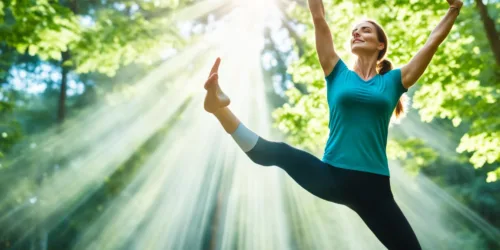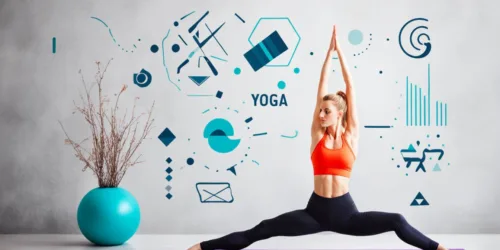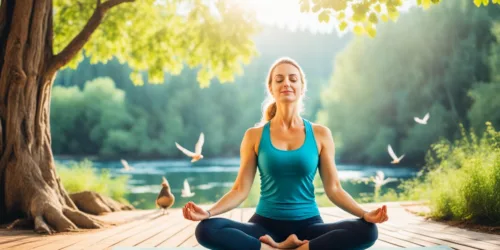10 Beginner Yoga Poses for a Serene Mind and Strong Body

If you’re a beginner at yoga, congratulations! You’re about to embark on an incredible journey that can lead to improved physical and mental health. We’ll explore the top 10 Beginner Yoga Poses in this article.
Yoga has been proven to reduce stress, improve sleep quality, increase flexibility and balance, and even boost your immune system.
One of the best things about yoga is that it’s accessible for people of all ages and fitness levels. Whether you’re just starting out with exercise or you’re a seasoned athlete looking to add some variety to your routine, yoga can be adapted to suit your needs.
And if you think yoga is just for flexible people who can contort their bodies into pretzel-like shapes, think again! There are plenty of beginner-friendly poses that will help you build strength and flexibility over time.
The Importance of Starting with Basic Poses In These 10 Beginner Yoga Poses
When it comes to starting your yoga practice as a beginner, it’s essential to start with basic poses. While it may be tempting to jump right into advanced poses that look impressive on Instagram, doing so can lead to injury and frustration.
By mastering the fundamentals first, you’ll build the foundation for a safe and effective practice. Basic poses like Mountain Pose (Tadasana) may seem simple at first glance but are key for understanding proper alignment and breathing techniques.
Other beginner-friendly poses such as Tree Pose (Vrksasana), Downward Facing Dog (Adho Mukha Svanasana), Warrior I Pose (Virabhadrasana I), Child’s Pose (Balasana), Cobra Pose (Bhujangasana), Bridge Pose (Setu Bandha Sarvangasana) are great options when just starting out- these are all included in our list of 10 yoga poses for beginners! Ultimately, starting with basic poses will give you the confidence and knowledge necessary to advance in your practice safely and effectively.
The Benefits of Yoga for Beginners
Yoga is a fantastic way for beginners to improve their overall well-being. It is a low-impact exercise that can be customized to any fitness level, making it an ideal way to incorporate physical activity into your daily routine.
One of the greatest benefits of yoga is its ability to reduce stress and anxiety. By focusing on breathing and mindfulness, yoga helps practitioners calm their minds and alleviate negative emotions.
In addition to reducing stress, yoga can also help with flexibility and balance. Many beginner yoga poses focus on stretching muscles and improving range of motion, which can help prevent injury in other physical activities or everyday movements.
Furthermore, practicing basic yoga poses also helps develop balance by engaging core muscles and increasing body awareness. These benefits extend beyond just the physical aspect; they can also increase confidence in one’s body as a whole.
The Importance of Starting with Basic Poses
It’s important for beginners to start with basic yoga poses instead of jumping straight into advanced postures. Basic poses like Mountain Pose (Tadasana) or Child’s Pose (Balasana) are simple yet effective ways to learn proper alignment and breathing techniques that will be used throughout your entire practice.
Another important reason for starting with basic postures is avoiding injury. Without building up strength over time, attempting advanced positions too soon may result in muscle strain or other injuries that could prevent progress in the long run.
By gradually introducing more challenging postures over time through regular practice of basic poses, beginners can safely build strength, flexibility, balance, and confidence necessary for more advanced lessons down the road. Starting with simpler sequences ensures beginners are comfortable enough before moving on to more complex routines so that they have greater enjoyment from doing it more frequently in the future!
The Steady Strength of Mountain Pose
Mountain pose, also known as Tadasana, is often considered the foundation for all standing poses in yoga. It may look like you’re just standing still, but this pose actually requires a lot of focus and mindfulness to get right. To stand in mountain pose, begin by standing at the top of your mat with your feet hip-distance apart.
Ground down through your heels and lift up through the top of your head to lengthen your spine. Engage your core muscles by drawing your navel towards your spine and pressing your shoulder blades down towards your waist.
Allow the arms to hang naturally by the sides with palms facing forward. The benefits of mountain pose are numerous.
First and foremost, it helps improve posture by aligning the spine properly. This can help reduce back pain and increase overall balance and stability in day-to-day activities.
By standing tall with good posture, it can also have a positive effect on self-confidence and self-esteem. In addition, mountain pose promotes better breathing habits by opening up the chest and lungs for deeper breaths – something we can all benefit from in our busy lives!
Tree Pose: Find Your Balance
Tree pose, also known as Vrikshasana, is one of the most iconic yoga poses for beginners. It’s a standing pose that helps you work on your balance and stability, while also strengthening your legs and core muscles.
Here are some step-by-step instructions to help you get started with tree pose: 1. Begin by standing tall with your feet hip-width apart.
2. Shift your weight onto your left foot and lift your right foot off the ground. 3. Place the sole of your right foot on your left inner thigh or calf (avoid placing it on the knee).
4. Bring both hands together in front of your chest in a prayer position. 5. Focus on a steady gaze ahead and find a point to focus on to help maintain balance.
6. Hold for 30 seconds to 1 minute before switching sides. If you’re just starting out with yoga or have limited flexibility, there are several modifications you can make to make tree pose more accessible:
– Place the sole of your foot against your ankle instead of higher up. – Keep one hand against a wall or chair for support.
– Instead of bringing both hands together at the heart center, try holding onto one elbow with the opposite hand. The benefits of tree pose extend far beyond physical benefits such as improved balance and strengthened muscles.
Practicing this pose can also help with mental focus and concentration, as well as promoting feelings of grounding and stability in everyday life. Be patient when practicing this pose, it may take time to find stability but once found it is very rewarding!
Downward Facing Dog
How to Do Downward Facing Dog
Downward facing dog, also known as Adho Mukha Svanasana in Sanskrit, is a foundational yoga pose that offers a host of benefits for beginners. Begin by coming to your hands and knees, with your wrists directly under your shoulders and your knees under your hips. Spread your fingers wide and press the palms of your hands into the ground.
Next, tuck your toes under and lift your hips up towards the ceiling while keeping a slight bend in the knees. Move your chest towards your thighs and keep pressing through your hands to lengthen through the arms.
Engage the legs by pressing down through the heels toward the ground. Take a few deep breaths in this posture before releasing.
Common Mistakes and How to Avoid Them
One common mistake made in downward facing dog is not engaging properly through the arms and shoulders. This can lead to unnecessary tension in these areas or even strain or injury over time. To avoid this, be sure to press firmly into both palms with fingers spread wide apart.
Another common mistake is allowing the lower back to round excessively in this pose, putting strain on this area of the body. To combat this, focus on lengthening through both sides of the waist evenly while keeping engagement in both legs.
Benefits of Downward Facing Dog
Downward facing dog is an excellent pose for beginners as it provides numerous benefits for both body and mind alike. This posture helps strengthen arms, shoulders, abs, and legs while stretching out hamstrings, calves, armpits, hands/wrists/forearms/shoulders blades/lower back/hips/calves/hamstrings , ankles ,heels . It also calms down stress-related hormones like cortisol because it allows you take deep breaths as well as increases blood flow and oxygen to the brain, resulting in better focus and concentration.
Additionally, this posture can help reduce anxiety and depression while improving overall mood. Add downward facing dog into your routine to feel grounded and start feeling these benefits for yourself!
Warrior I Pose
Instructions on How to Do Warrior I Pose
Warrior I pose is a foundational standing pose that builds strength and stamina in the legs, core, and upper body. Here’s how to do it:
1. Begin in mountain pose with your feet hip-width apart and your arms at your sides. 2. Step your left foot back about three to four feet, keeping both feet parallel to each other.
3. Turn your left foot out 90 degrees so that it’s pointing towards the side of the mat. 4. Bend your right knee until it’s directly over your ankle, making sure not to let it go past your toes.
5. Square your hips towards the front of the mat. 6. Raise both arms straight up towards the ceiling, palms facing each other.
Variations and Modifications for Beginners
Warrior I pose can be challenging for beginners, so here are some variations and modifications you can try: – If you have trouble keeping both feet parallel to each other, try turning your back foot in slightly.
– If you find it difficult to bend deeply into the front knee without losing balance, reduce the bend in the knee until you feel more stable. – Place a block under your bottom hand if reaching all the way up is too challenging for now.
Benefits of Warrior I Pose
Warrior I pose offers many benefits beyond building strength in various parts of the body: – It improves balance by strengthening muscles in both legs
– It stretches muscles around hips that may become tight from sitting for long periods – It opens chest which can improve breathing
– It promotes mindfulness by demanding focus on aligning movement with breath Overall, warrior I pose is an excellent foundation for any yoga practice as well as daily life movements involving strength in lower body and balance between stability and flexibility.
The Comfort of Child’s Pose
Child’s pose can be a relief for those who are new to yoga or have tight muscles. It is a restorative and calming pose that can be used at any point in the practice as a way to regain focus, catch your breath or take a break from more challenging poses. Let’s explore how to get into child’s pose, modifications for those who need it and the many benefits it has to offer.
Getting Into Child’s Pose
To get into child’s pose, start on your hands and knees with your fingers spread wide open. Keep your wrists directly under your shoulders, and your knees hip-width apart.
As you exhale, lower your hips back towards your heels with control. Your forehead should rest on the mat and arms should be extended forward or alongside the body along with palms facing up.
Modifications for Those With Pain
Child’s pose can be modified to accommodate different levels of flexibility or pain conditions by using props such as blocks, blankets, bolsters or pillows . To create more space between the back of the thighs and calves, place a blanket between them. For extra support under the head/neck use a block or pillow under it which also makes this pose more comfortable for people with neck pain.
If you have tight hips, feel free to widen them apart when setting up in child’s pose so that there is no stress on knee joints. If knee pain is present then fold a blanket under them so they are elevated above ground level.
Benefits of Child’s Pose
Child’s pose stretches hips, thighs (quadriceps), ankles while also reducing stress levels by increasing blood flow throughout the body due to its inverted posture . The resting position of child’s poses calms down nervous system , which leads towards higher levels of relaxation as well as improved digestion.
The pose also improves circulation and is a great way to release tension in the muscles after a long day. Child’s pose promotes better flexibility, circulation, and relaxation, making it one of the foundational poses in yoga.
It is an accessible posture for everyone – beginners, pregnant women or those with back pain. Incorporating child’s pose into your daily practice can help you build strength and endurance while also allowing you to unwind and let go of stress.
Cobra Pose: The Stretching Snake
Cobra Pose or Bhujangasana is an asana that mimics the pose of a cobra with its hood raised. This pose, though it looks simple, has multiple benefits for the body. It helps stretch and strengthen the muscles in the back, arms, and shoulders while also opening up the chest and lungs.
Step-by-Step Guide on How to Do Cobra Pose
To start this pose, first lay down on your stomach with your hands placed directly underneath your shoulders. As you inhale deeply, press down into your hands and lift your chest off the ground while keeping your elbows close to your sides.
Hold this position for a few breaths before slowly lowering yourself back down onto the ground as you exhale. While doing this pose, make sure to keep your shoulders away from your ears and gaze forward instead of looking up towards the ceiling to avoid straining the neck muscles.
Tips on Proper Alignment and Breathing Techniques
It is essential to maintain proper alignment when practicing Cobra Pose to avoid injuries or discomfort. Make sure that as you lift yourself off of the ground using only your upper body strength while keeping your legs together. In terms of breathing techniques during this pose, inhale deeply through your nose as you lift up into Cobra Pose and exhale slowly through pursed lips as you lower yourself back down onto the ground.
Benefits of Cobra Pose
Apart from being an excellent way to stretch out tired muscles in multiple areas of the body such as arms, chest, shoulders and back muscles; Cobra Pose can help improve posture by elongating spinal muscles. This posture can also help reduce tension headaches by releasing pressure in chronic problem areas along with calming mental stress levels.
Practicing this movement regularly can also increase flexibility in these same muscle groups, so don’t be afraid to hold it for longer periods of time as you get more comfortable with the pose. Enjoy the benefits of this cobra stretch and feel your body relax into its natural state of balance!
Bridge Pose
Instructions on how to do bridge pose
Bridge pose is a great way to strengthen your lower back, glutes, and hamstrings. To begin, lie on your back with your knees bent and feet flat on the floor. Your feet should be hip-width apart and close enough to touch with your fingertips.
Keep your arms by your sides with palms facing down. On an inhale, press into your feet and lift your hips up towards the ceiling.
Keep pressing down through all four corners of both feet while engaging your glutes and inner thighs. You can interlace your hands underneath you or maintain the position of having them by your side for support.
Variations and modifications for beginners
If you’re having trouble maintaining the lift in bridge pose, try placing a block or pillow underneath your sacrum (the bony part at the base of the spine) for support. This will help create space in the lower back while still allowing you to work on building strength.
For an extra challenge, try lifting one leg up towards the ceiling while maintaining a steady hold in bridge pose. Make sure to keep both hips level throughout this modification so that you’re not putting too much pressure on one side.
Benefits of Bridge Pose
Bridge pose not only strengthens the lower body but also improves spinal flexibility by stretching out the chest, neck, and spine. It’s a great way to release tension in these areas after sitting for long periods of time or if you have tightness from previous workouts. Additionally, bridge pose can be therapeutic for those suffering from mild anxiety or depression as it helps stimulate blood flow throughout the body while calming down racing thoughts.
Final Thoughts On The Top 10 Beginner Yoga Poses
Incorporating these 10 yoga poses into a daily routine is an excellent way for beginners to build strength, increase flexibility, and reduce stress. Even if you only have a few minutes, taking the time to practice these poses can make a big difference in your physical and mental well-being. Remember to listen to your body and modify as needed, especially if you’re new to yoga or dealing with an injury.
With regular practice and patience, you’ll be amazed at how much progress you can make. So roll out your mat, take a deep breath, and let’s get started!






